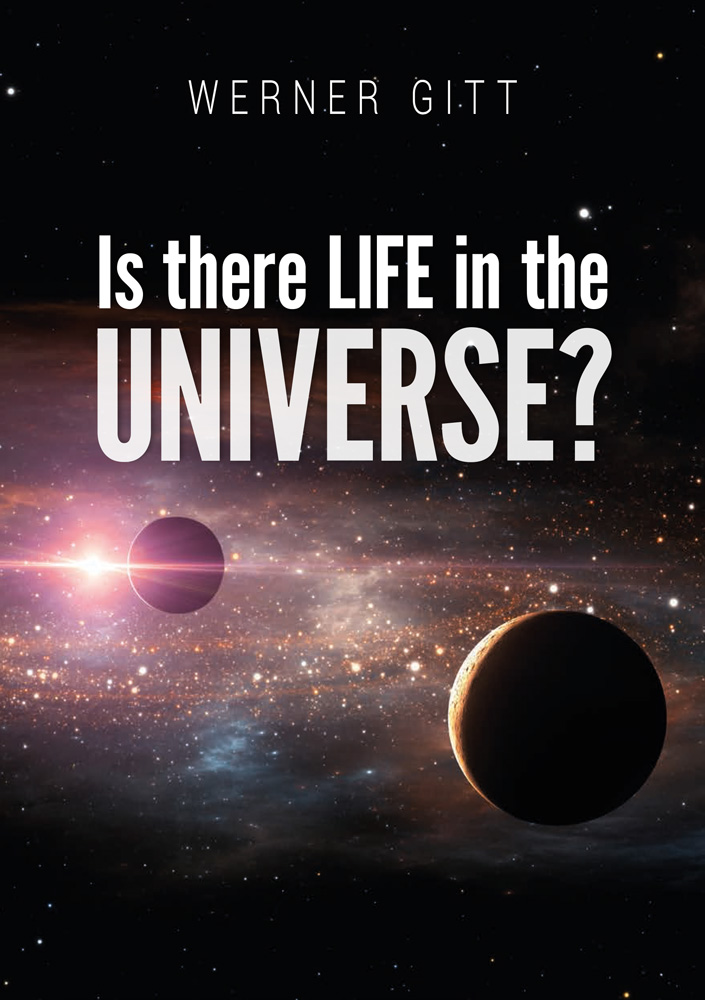Englische Verteilschriften
ShareProf. Dr. Werner Gitt
Englisch: Leben im All – Spekulationen und Fakten
Is there Life in the Universe?
Abgesehen von den derzeit alles überragenden Themen Coronakrise und Klimawandel wird kaum einer anderen langlebigen Idee so viel Aufmerksamkeit gewidmet wie der Frage, ob es irgendwo in den Weiten des Universums wohl auch noch Leben gibt.
Beflügelt durch die Evolutionstheorie glaubt man weithin, dass Leben von alleine entstehen kann, wenn nur die geeigneten physikalischen und chemischen Bedingungen erfüllt sind. Die ständig wachsende Zahl von neu entdeckten Exoplaneten fördert die Spekulationen über extraterrestrisches (außerirdisches) Leben. Aus naturwissenschaftlicher und biblischer Sicht wird in dieser Schrift geprüft, ob diese Hoffnung eine Berechtigung hat.
16 Seiten, Best.-Nr. 142-3, Kosten- und Verteilhinweise
Is there Life in the Universe?
Other than the coronavirus pandemic or climate change, it’s likely nothing gets as much attention as the question of whether there might be life in the universe beyond Earth, somewhere in the vastness of space.
Spurred on by evolutionary theory, it is widely believed that life can arise by itself, provided only that the appropriate physical and chemical requirements are present. The constantly growing number of newly discovered exoplanets further promotes this speculation about alien (extraterrestrial) life. Let’s examine—from a scientific and biblical perspective—whether this hope is justified.
1. An old idea with a new impetus
Belief in the possible existence of extraterrestrial life forms, based on mythical imaginings, stems from antiquity. In the 17th century, the renowned Dutch astronomer and mathematician Christiaan Huygens (1629–1695) thought that the existence of extraterrestrial life was more than plausible.
As the cofounder of probability theory, he maintained that life in other parts of the universe was more probable than the alternative, that there was none. His notion of ‘reasonable conjectures’ has influenced natural philosophy up to the present day.
Speculations about extraterrestrial life received a strong boost in the second half of the 19th century, as Darwin’s theory of evolution became increasingly popular. In modern form, this holds that through natural processes of mutation and selection, life on Earth has developed over billions of years from very simple life forms to ever increasing variety and higher complexity—and eventually also to intelligence. It has achieved the status of an all-conquering worldview.
This readily leads to the notion that there could have been a comparable development on some other planet in the universe. Till recently, though, it was not clear whether other suns in the universe had planets like those of our own sun. For many years, astronomers assumed that the planets circling our sun could well be the only ones in the universe.
The idea of life elsewhere in the universe received a big further boost when it became possible for the first time to identify an exoplanet, that is, one outside of our solar system. When it comes to speculations about extraterrestrial life, planet-hunters undoubtedly hold a trump card; their announcements are certain to attract great attention.
It was the two Swiss astronomers from the University of Geneva, Michel Mayor and Didier Queloz, who observed tiny wobbles in the motion of a star. From this, one could assume that the gravitational force from another heavenly body was affecting the star. They discovered something hitherto unknown, namely that this wobbling was from a planet orbiting a sunlike star.
6 October 1995 became a special day in the history of astronomy, as Mayor and Queloz announced they had discovered the first star—outside of our sun—which had a planet orbiting it. The discovery of the exoplanet 51 Pegasi b was a landmark breakthrough in the history of astronomical research. For this first-ever discovery of an exoplanet, the two astronomers received the Nobel Prize in Physics in Stockholm, on 8 October 2019.
The sunlike yellow dwarf star 51 Pegasi, with its exoplanet 51 Pegasi b, is found in the constellation of Pegasus, and is about 40 light-years from Earth. This planet is probably a hot gas giant, or ‘hot Jupiter’ as similar exoplanets are known. Its radius is nearly twice as big as Jupiter but it has only half the mass. Since it orbits 51 Pegasi in only 4.2 Earth-days, it’s significantly closer than Mercury is to our sun. Its surface temperature has been estimated to be a searing 980 degrees Celsius.
The ‘b’ in the planetary name 51 Pegasi b means that this was the first planet discovered to be orbiting its parent star 51 Pegasi. If this star turned out to have more exoplanets, these would be named ‘c‘, ‘d‘, and so on, in chronological order of discovery.
Since the discovery of the first exoplanet, astronomers have been on somewhat of a frenzied hunt for additional examples. With this fevered search for further exoplanets in full swing, it is as if astronomy has a new reigning discipline.
The strong motivation and inspiration for this work is the thought of finding life somewhere else in the universe.
51 Pegasi b was discovered through the so-called radial velocity method. Under the influence of gravity, the star and planet move around their common centre of mass. Because of its substantially greater mass, the star moves to a much lesser extent than the planet. These movements allow us to deduce the existence of the planet.
The most frequently employed method of tracking exoplanets is the transit method. If the orbital path of the planet from the viewpoint of the earth lies exactly in front of the star, then as the planet passes (transits) between the earth and the star, the star’s brightness will be very slightly dimmed. Only high-precision photometry can reveal when the exoplanet passes in front of its central star.
As at 11 May 2019, 4,062 exoplanets in 3,038 systems had already become known. Since the first exoplanet discovery, the number discovered every year has been steadily rising, as the following examples show: 2000 (22), 2002 (31), 2007 (60), 2010 (126), 2013 (199), 2014 (846), 2016 (1,474).
The number and variety of these
planets is in excess of anything predicted by models of planetary formation.
So we can anticipate ongoing discoveries that will further increase their number. As the count rises, so too does the euphoria in anticipation of soon finding an Earth-like planet that is host to life.
2. EXOPLANETS IN THE HABITABLE ZONE ARE OF PARTICULAR INTEREST
Exoplanets which lie in the so-called habitable zone are like a high-carat diamond to prospectors.
The notion of this livable zone refers to the range of distance a planet must be from its central star to enable the sustained existence of liquid water.
This ring-shaped habitable zone encircles the star at a distance that varies depending on star type and luminosity. In our solar system, this habitable zone is between about 0.95 and 1.6 astronomical units (AU). 1 AU (149,597,870.7 km) is the distance from the sun to the earth, so we are right within this zone of life—a stroke of luck for us, astronomers say.
Other parameters thought necessary to permit Earth-like life on the surface of an exoplanet involve climatic conditions in addition to liquid water. It was previously thought that habitable zones were only possible for stars with a similar size to our sun. More recently, red dwarfs are also included in such considerations. But that leads to a different problem: For stars with under 0.5 solar masses, the zone of sufficient energy is so close to the star that the rotation of the planet becomes synchronised with its orbital period. So the same side of the planet will always face its central star, resulting in no alternation of night and day. This means one side will be intolerably hot, while the other is freezing cold.
Earth Similarity Index (ESI): This scale from 0 to 1 rates how similar a celestial body is to Earth, whereby a value of 1 corresponds to Earth. Developed for planets and exoplanets, the score is calculated from the radius, density, cosmic velocity and surface temperature. In our solar system, the highest value other than Earth is Mars at 0.697.
Rocky planets with a solid surface, and which also have sufficient gravity to form a spherical shape, are called Earth-like planets. Because of limitations in the accuracy and capabilities of the measuring process, determining whether an exoplanet is Earth-like is difficult.
3. EXAMPLES OF EARTH-LIKE EXOPLANETS
Kepler-186f orbits a red dwarf about 490 light-years away, in the constellation Cygnus. Among the six planets detected around the star to date, Kepler-186f qualifies as Earth-like.
Its mass and also its radius are some 1.1 times that of Earth. It takes 130 Earth-days to completely orbit its central star. Though its distance from the star is significantly less than that of the earth from the sun, it receives correspondingly less energy by comparison, and thus probably lies right at the outer edge of the star’s habitable zone.
Kepler-452b was discovered in July 2015 as an exoplanet of the star Kepler-452, a yellow dwarf 1,800 light-years from Earth, again in the constellation Cygnus. It has an orbital period of 385 Earth-days. Its diameter is 60 % greater than that of Earth and it has double the gravitational force. Its star is very much like our sun, and Kepler-452b is regarded as one of the most Earth-like planets.
The Trappist-1 system: The Trappist-1 star system[1], a red dwarf star 40 light-years from Earh in the constellation Aquarius, contains in total seven Earth-like planets, whose masses and diameters resemble that of Earth and on which there could be liquid water. The central star is a low-mass red dwarf. NASA believes that the planets Trappist-1 e, f and g are in the habitable zone. Astronomer Michaël Gillon was involved with the discovery, and sees systems like Trappist-1 as the most auspicious candidates for possible life.
K2-18b, an exoplanet 124 light-years from us and discovered in 2015, is rated as the hitherto most promising candidate in the search for life outside of our solar system; its trajectory is within the life-friendly zone. The central star is a red dwarf in the constellation Leo.
Planets that are two to ten times the mass of Earth are called superearths by astronomers. K2-18b has eight times the mass of Earth and is about twice its size. It orbits its red dwarf star with an orbital period of 33 days and thus—as seen from Earth—regularly transits its central star. In 2019, with the aid of the Hubble Space Telescope, astronomers were able to demonstrate water in the atmosphere of K2-18b, the first time for any exoplanet.
With all the discoveries of exoplanets to date, it can be said that so far not a single one has been found that even comes close to exhibiting all the conditions that are realised on our Earth. Based on many parameters, our planet is optimally designed for life.
We will here name only twelve among many further necessary conditions:[2]
1. The right distance to the sun
2. The right speed of rotation
3. The right length of year
4. The right inclination of the earth’s axis
5. The right mass and size
6. The unique composition of the earth’s atmosphere
7. The right density of the atmosphere
8. The indispensable ozone layer
9. The right magnetic field
10. The right moon size
11. The right distribution of land and sea
12. The necessary mineral resources
That such a planet could form by chance mechanisms can be ruled out on statistical grounds.
Given all the above facts, the question is, whether there could be life somewhere else in the universe. We will seek to answer this from two perspectives—from a scientific and biblical viewpoint.
4. LIFE IN THE UNIVERSE?—
A SCIENTIFIC VIEWPOINT
It‘s notable that all of the conditions for life put forward by astronomers and planetologists exclusively involve material quantities like e.g. gravitational force, surface temperature, the existence of water, and an atmosphere.
This reflects a captivity to the constraints of evolutionary thinking, with its commitment to materialism. But even if all the material preconditions were ideally fulfilled, life could never arise, because the most important ingredient of all—information—would be missing.
The Natural Laws of Information give us a certain answer to whether life could even develop in a purely material system. Information is the non-material basis of all conceivable forms of life, since it is required for the storage of all body plans and their transmission to the next generation.
The four Natural Laws of Information (NLI)[3] are:
NLI-1: A material entity cannot give rise to a non-material entity.
NLI-2: Information is a non-material entity.
NLI-3: No information can arise in stochastic processes (= events without guiding intelligence).
NLI-4: Information can only arise through an intelligent source (sender).
Proofs come in two forms; soft proofs like historical or legal documentation, which are potentially refutable—and hard (irrefutable) proofs, known only from mathematics and natural (scientific) laws. Thus the natural law NLI-4 is a hard proof for the fact that even in the presence of all favourable material preconditions, information can never arise without an intelligent sender.[4] Scientifically, this is the DEATH KNELL of evolutionary theory.
In order to be able to speak of a truly living thing, there is also a further non-material factor that comes into the picture—namely life. Life is the state that all living creatures have in common which distinguishes them from dead matter. The essence of life—that which makes something ‘alive’—is, like information, a non-material entity. Let’s call this non-material property ‘aliveness’ for want of a better English word.
For living things we can formulate the following natural laws of life (NLL):
NLL-1: ‘Aliveness’ is a non-material property.
NLL-2: ‘Aliveness’ is that property which defines the difference between life and death.
The French chemist and microbiologist Louis Pasteur is the source of the dictum, proven millions of times over: Vivum ex vivo—life can only come from life. With this we come to the third law:
NLL-3: Something which is alive cannot arise by itself from matter; its origin requires a non-material source, a source of life.
This source cannot itself be material; rather, this demands an intelligent
and life-giving source. Who this source is cannot be answered scientifically. For this we need a higher source of information, which we will use in what follows.
5. LIFE IN THE UNIVERSE?—
A BIBLICAL VIEWPOINT
The statement of the law NLL-3 matches the Bible. Where science is powerless to reach a conclusion, the Bible enables us to fill in the blanks.[5]
Psalm 36:9 states: “With you is the fountain (source) of life”, and in John 14:6 Jesus says of Himself: “I am ... the life”. Since no life can arise without the Creator, this also means that life cannot arise by itself anywhere else in the universe—not in any habitable zone, nor on any Earth-like planet—even if one of them were to exhibit the identical atmospheric and planetary conditions to those we know from our own Earth.
So now there only remains the question of whether God could have established life somewhere else in the universe other than Earth. The Bible does not give a direct answer to this, but—as is so often the case—we can deduce a clear answer from the total testimony of the Bible.
God at first created only a water-covered Earth hanging free in space. It was only on the fourth creation day that God supplemented His work by way of the sun, moon and stars (Genesis 1:16). Their task was “to give light on the earth“ (v. 17), i.e. their purpose was not to host other realms of life, but rather everything was made for mankind. In association with Earth’s orbit and rotation, they were to effect the alternation of day and night, as well as to serve as markers of time and seasons (v. 14). The stars of the heavens also have the important purpose of proclaiming to us the glory of God and His creative power (Psalm 19:1; Romans 1:20). The Bible also speaks of the future of the universe (e.g. the return of Jesus, the end of the world). Everything will one day be rolled up like an aged garment (Isaiah 34:4; Revelation 6:14, Hebrews 1:12).
Had God created life elsewhere as well, He would be automatically destroying its abode in the process.
Briefly summarised: The natural laws of information exclude the idea of life originating by evolution. Such ideas are also foreign to the Bible from the outset. From the overall context of the Bible, we can conclude that God did not create life in the universe other than on Earth.
6. LIFE BEYOND TIME AND SPACE
From both the Bible and science we can confidently assume that there is no life on any other planet in our universe. There is, nonetheless, life beyond time and space, referring to those spatial dimensions that go beyond our three-dimensional world.
God, Jesus, and the world of heavenly angels are in a dimension beyond our own; which dimension that is, we do not know. This reality, not visible to us, is supported by numerous biblical passages. In Psalm 139:7–10 the Psalmist asks: “Where shall I flee from your presence? If I ascend to heaven, you are there! If I make my bed in Sheol, you are there! If I … dwell in the uttermost parts of the sea, even there your hand shall lead me, and your right hand shall hold me.” Two verses earlier, he says, “You hem me in [surround me completely], behind and before” (v. 5). Wherever we might be, God is there, literally surrounding us on all sides. This makes complete sense if God exists in a higher dimension that permeates our own.
God further tells us in Jeremiah 23:24: “Can a man hide himself in secret places so that I cannot see him? declares the Lord. Do I not fill heaven and earth? declares the Lord.“ There is no place on Earth nor anywhere in the universe where we can hide from Him; He is present everywhere and sees us.
For more details on this, see the video “Jesus beyond space and time”:
wernergitt.com/space-and-time
7. OVERCOMING THE THREE-DIMENSIONAL
No matter how far we were to travel into this universe using superfast rockets, we would not be able to escape or overcome the limitations of our three dimensions. But with God it is possible. The Bible more than once provides examples of how, on occasions, individual persons were able to overcome this barrier:
7.1 Stephen’s view of Heaven
Acts 7:55–56 speaks of this in connection with the stoning of Stephen: “But he, full of the Holy Spirit, gazed into heaven and saw the glory of God, and Jesus standing at the right hand of God. And he said, ‘Behold, I see the heavens opened, and the Son of Man standing at the right hand of God.’” God had opened Stephen’s eyes in such a way that he could see into the higher dimension of God. The ‘curtain of the event horizon’ was drawn aside just for him, so that from his standpoint before the gates of Jerusalem, he could see directly into Heaven. Heaven is thus not somewhere beyond the universe, but directly around us, though in another dimension.
7.2 The resurrection of Jesus
After His resurrection, the body of Jesus was no longer comparable to our own. He was not bound to the three-dimensional anymore, but could rather appear at will in our 3-D world, then shift to the heavenly dimension again. The philosopher Martin Heidegger, who was not arguing from the standpoint of belief, correctly affirmed:
“If Jesus of Nazareth rose from the dead, then every scientific finding is only provisional.”
He had recognised that if Jesus really did rise from the dead, all our scientific knowledge can never be the be-all and end-all of understanding. In 1 Corinthians 15:6 Paul tells us: “Then he (= Jesus) appeared to more than five hundred brothers at one time.“ In the original Greek, this occurrence is expressed even more precisely: “He was made visible.“ This means that Jesus was present before that, too; it’s just that He had then been made visible in our dimension.
7.3 The ascension of Jesus
The ascension of Jesus is another instance of where our three-dimensional world was overcome:
“So then the Lord Jesus, after he had spoken to them, was taken up into heaven and sat down at the right hand of God.“ (Mark 16:19).
Jesus was taken into a dimension which is still invisible to us.
In Acts 1:9 we read: “And when he had said these things, as they were looking on, he was lifted up, and a cloud took him out of their sight.“ And then the angels said (v. 11): “Men of Galilee, why do you stand looking into heaven? This Jesus, who was taken up from you into heaven, will come in the same way as you saw him go into heaven.” Here the key phrase is “in the same way“, i.e. transiting between dimensions. At His return, He will emerge from the heavenly dimension and be simultaneously visible to all people, regardless of whether we live in Germany, Australia, China or America.
7.4 The return of Jesus
Until recently in the media, the overwhelming theme dominating all others was the ‘climate catastrophe’. Panic is taking hold in all nations. Greta Thunberg, the 16-year-old Swedish climate activist, is invited to address the UN in September 2019 with an emotional lament that young people are being robbed of their future, and is awarded the ‘alternative Nobel prize‘. In their models, scientists calculate the impending catastrophic rise in temperature, the melting of the ice and the rise of the sea level.
None of these scenarios of the future even mentions the greatest future happening of all—the return of Jesus.
The real plight of our time is that this, the world’s greatest ever and soon-coming event, is largely concealed and ignored. What a shock it will be for all who have lived without Jesus, to then see Him, suddenly and completely unexpectedly, appear in the clouds of the sky as judge of all the world!
According to Matthew 24:27 the return of Jesus will take place in an instant—from one second to the next: “For as the lightning comes from the east and shines as far as the west, so will be the coming of the Son of Man.“ The Lord will be instantly and simultaneously visible to all people. Even someone who at that moment finds themselves 1000 metres below the earth’s surface in a salt mine will see Him. There will be no barrier to His visibility. It will be as Jesus said at His ascension: “And they will see the Son of Man coming on the clouds of heaven with power and great glory” (Matthew 24:30).
Luke’s gospel makes it clear that at the time of the Lord’s return, on one side of the globe it will be day, and on its opposite side, night: “I tell you, in that night there will be two in one bed. One will be taken and the other left. There will be two women grinding together. One will be taken and the other left” (Luke 17:34–35).
How precise the Bible is! The task of grinding is normally done in the day. It will be simultaneously night and day; which it is for us will depend on which part of the rotating earth we find ourselves upon at that moment. Those who follow the conspiracy theory that, despite all the certain conclusions from both science and the Bible, we live on a flat earth, should also take note.
8. A NEW HOME FOR US
In John 14:2 Jesus says to His followers: “In my Father’s house are many rooms. If it were not so, would I have told you that I go to prepare a place for you?“ These are situated beyond our dimension, and are planned by Jesus as eternal abodes in the heavenly world. His statement “Come to me“ (Matthew 11:28) invites us all to be there.
There is only one way that leads to this house of the Father, and that is Jesus: “Whoever believes in the Son (of God) has eternal life“ (John 3:36a). The second part of this verse does not shrink from presenting the alternative: “Whoever does not obey the Son shall not see [eternal] life, but the wrath of God remains on him“ (3:36b).
Wise counsel here can only be: Turn today to this eternal king and saviour, Jesus Christ, and invite Him in a prayer to take over the direction of your life. Then follow Him in consequence, by doing that which the biblical Word tells you.
We invite you to make use of the offers on the accompanying coupon. They will help you to learn more about life with Jesus Christ.
Director and Professor (retired)
Dr Werner Gitt Ph.D.
[1] solarsystem.nasa.gov/news/335/10-things-all-about-trappist-1/
[2] W. Gitt: Stars and their Purpose–Signposts in Space, CLV-Verlag, 2nd English edition 2000, pp. 141–153. Free download: clv.de/index.php?cl=details&anid=1486
[3] W. Gitt with B. Compton and J. Fernandez: Without Excuse—Information: the Key of Life, Creation Book Publishers, 1st edition 2011, pp. 124–129.
[4] Of course, information can be transmitted via an existing programmed mechanism, as when an organism generates a copy of itself. But such programming is never seen to arise spontaneously. It requires intelligence—either the direct action of a sender or in the form of a program that itself originated from either a sender or from a chain of programs in which the first link required a sender.
[5] On the basis of the over 3,000 fulfilled prophecies in the Bible its truth can be mathematically demonstrated. This prophetic-mathematical proof of God is comprehensively presented in ref. 3, pp. 211–219.
Neue Artikel im Shop
 Warum Gottes Liebe entscheidend ist!
Wir brauchen Liebe und wollen Liebe! Doch was ist Liebe eigentlich und wie...
mehr
Warum Gottes Liebe entscheidend ist!
Wir brauchen Liebe und wollen Liebe! Doch was ist Liebe eigentlich und wie...
mehr
 Gibt es eine Generalamnestie für die Sünden aller Menschen?
Aufgrund des Kreuzestodes Jesu bietet Gott allen Menschen das Heil an, darum...
mehr
Gibt es eine Generalamnestie für die Sünden aller Menschen?
Aufgrund des Kreuzestodes Jesu bietet Gott allen Menschen das Heil an, darum...
mehr









